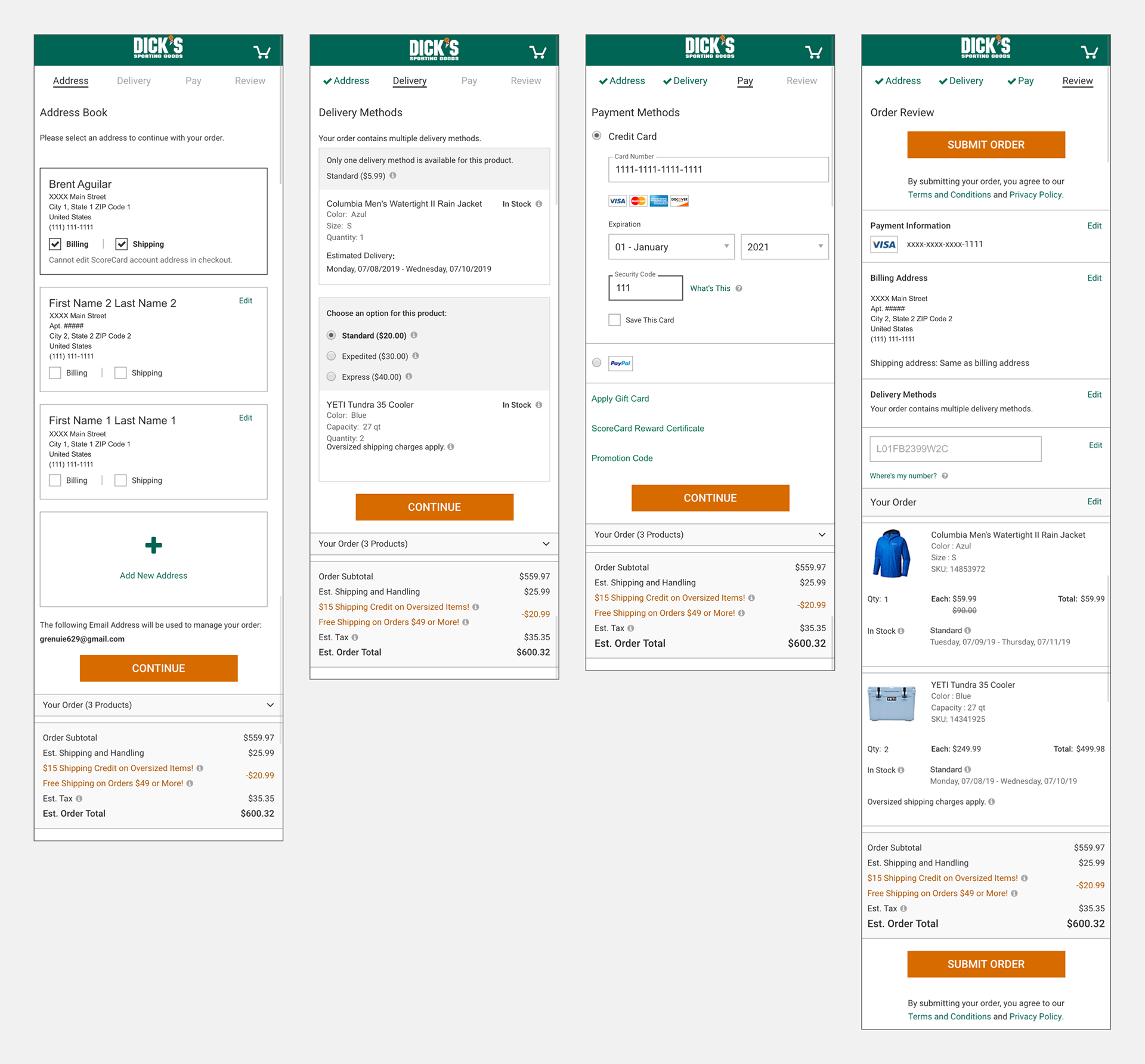Setting the Scene
Background:
Product teams at Dick’s Sporting Goods are organized as one Designer, one Product Manager, and eight to ten Engineers. It was determined that the Online Checkout legacy systems were ineffective, built with workarounds, and dependent on 3rd party resources. My mission was to create a new experience, focusing on a single source of truth codebase for online shoppers.
Product teams at Dick’s Sporting Goods are organized as one Designer, one Product Manager, and eight to ten Engineers. It was determined that the Online Checkout legacy systems were ineffective, built with workarounds, and dependent on 3rd party resources. My mission was to create a new experience, focusing on a single source of truth codebase for online shoppers.
My efforts:
- Act as Designer and Product Manager for the duration of the project.
- Facilitate discovery work with stakeholders and end-users to collect needs.
- Run Discovery efforts and document findings to be shared with the project team through visual artifacts in biweekly demos.
- Pair with Developers to design low-fidelity solutions for testing with end-users. Design higher fidelity iterations.
- Act as Designer and Product Manager for the duration of the project.
- Facilitate discovery work with stakeholders and end-users to collect needs.
- Run Discovery efforts and document findings to be shared with the project team through visual artifacts in biweekly demos.
- Pair with Developers to design low-fidelity solutions for testing with end-users. Design higher fidelity iterations.
Discovery
Discovery Research
- Conducted 15 stakeholder interviews.
- Wrote research plans and goals and conducted 80 end-user interviews in the field.
- Documented and synthesized findings from research efforts.
- Shared observations and findings from interviews and customer intercepts in biweekly demos.
- Conducted 15 stakeholder interviews.
- Wrote research plans and goals and conducted 80 end-user interviews in the field.
- Documented and synthesized findings from research efforts.
- Shared observations and findings from interviews and customer intercepts in biweekly demos.
Research Findings & Product Roadmap :
- Users were ultimately interested in their online checkout experience being simple, convenient, and fast.
- Auto-populating information is table stakes.
- The fewer clicks, the better for users who are in a rush and want to feel confident in their checkout experience.
- Users were ultimately interested in their online checkout experience being simple, convenient, and fast.
- Auto-populating information is table stakes.
- The fewer clicks, the better for users who are in a rush and want to feel confident in their checkout experience.


Design & Iterations
Solution (Left) & Responsive Breakpoints (Right):
- Designs started as sketches and matured to static prototypes through a series of usability tests, critiques within the Technology Department, and collecting feedback from users in the field. Dynamic prototypes were tested with users ahead of development.
- Design focused on auto-populating as much information as possible, streamlining decision-making, and increasing user information transparency.
- Reduced the number of pages across the experience
- The solution was designed to be fully responsive and 508 compliant.
- Designs started as sketches and matured to static prototypes through a series of usability tests, critiques within the Technology Department, and collecting feedback from users in the field. Dynamic prototypes were tested with users ahead of development.
- Design focused on auto-populating as much information as possible, streamlining decision-making, and increasing user information transparency.
- Reduced the number of pages across the experience
- The solution was designed to be fully responsive and 508 compliant.



Testing Designs in the Field:
- Designs were launched with a survey link within the experience. I
- 150 surveys including short and long-form questions were returned within two weeks. This represented 500 unique pieces of information.
- The information was synthesized and classified into "Customer Feedback" and "Bugs."
- Findings were worked into the road map for relevant MVP implementation needs.
- Designs were launched with a survey link within the experience. I
- 150 surveys including short and long-form questions were returned within two weeks. This represented 500 unique pieces of information.
- The information was synthesized and classified into "Customer Feedback" and "Bugs."
- Findings were worked into the road map for relevant MVP implementation needs.